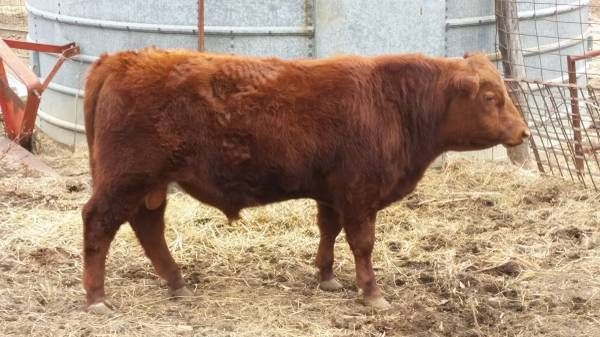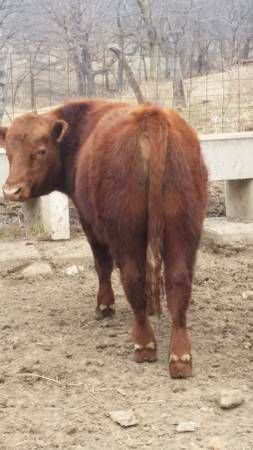|
|
Post by kansasdexters on Mar 17, 2015 20:36:29 GMT -5
Okay, here is a very interesting write-up on the history of the Red Angus breed. Many times, we hear or read about people making comments (sometimes negative comments) concerning how much red, polled Dexter cattle look like Red Angus cattle. Knowing the history of the Red Angus breed is helpful in understanding the common origins of both the Angus and Dexter breeds (and other British breeds). A common ancestral/contributing breed to both of these breeds was very likely the British Shorthorn, because the Shorthorn breed was considered by many cattle breeders of the time, to be the "great improver" in the early 1800's, and Shorthorn bulls were used extensively in England, Ireland, and Scotland (as well as in many other countries). assets.redangus.org/media/Documents/Association/Red_Angus_History_Brochure.pdfHere are some photos of a 13-month old, Red Angus bull, and he weighs approximately 830 lb:   |
|
|
|
Post by J & M Chambers on Mar 17, 2015 21:23:31 GMT -5
Patti, that statement "....dexter cattle look like Red Angus cattle", while I'm not questioning your assertion that it has been expressed, in my opinion indicates way more about the relative cattle knowledge and experience of one who expresses it than anything else. Do we know if the the persons that make such assertions have ever been in close proximity to a red angus? And close proximity for this purpose would perversely actually include within a country mile! I love our breed dearly but even the most well built beef trending type of dexter is not the meat animal an average red angus is. And let's not even begin to suggest a size comparison.  Seriously, I would think a single day of observation at any major state fair during the beef OR dairy cattle shows would so very beneficial sometimes as basic, immersion training for anyone choosing to start raising cattle.  |
|
|
|
Post by kansasdexters on Mar 17, 2015 21:43:17 GMT -5
Jeff,
I agree with your statement concerning relative cattle knowledge and experience, since I have seen Red Angus cattle (down the road from me is a nice herd of them) and I know that they don't look like the red polled Dexter cattle. But the comments (and the negativity associated with those comments) continue to be expressed on a regular basis and unchallenged by those of us that know better. So, let's take a look at this from a real life perspective and openly discuss it, and shares photos and experience. This is an opportunity to learn more about what sets the Dexter breed apart from other British breeds, and what similarities they may share with other British breeds.
Patti
|
|
|
|
Post by J & M Chambers on Mar 17, 2015 22:01:59 GMT -5
Very good Patti. In that spirit: Something that has allowed the red angus breed to become such a tremendous beef animal is their association's emphasis since inception and fidelity to objective data as a major tool in breeding decisions and operations. While dexter goals maybe different the approach is something we could aspire to employ. From the Red Angus Assocation's first president in 1954, Waldo Forbes, Sr. The History of Red Angus“The policy of the (Red Angus) Association
is to discourage the more artificial practices
in purebred cattle production and to place its
faith instead in objective tests, consisting for
the most part of comparisons within herds of
factors of known economic importance and
known heritability... By making this an integral
part of the registration system, Red
Angus breeders feel that even faster progress
can be made toward the ultimate goal of
more efficient beef production.” Jeff |
|
zephyrhillsusan
member
Caught Dexteritis in Dec. 2009. Member of this forum since Oct. 2013.
Posts: 1,502 
|
Post by zephyrhillsusan on Mar 17, 2015 22:03:16 GMT -5
Thanks for the article, Patti. That was quite interesting. The part below caught my eye:
I also noted the breed-wide weaning data at 205 days and the fact that every cow's production is recorded every year, or she is inactivated. Obviously these things are not going to happen in the Dexter breed as a whole, but they are interesting points.
|
|
|
|
Post by legendrockranch on Mar 18, 2015 12:06:16 GMT -5
Hi Patti,
I really didn't want to step on any ones toes when I mentioned I would post the link you put on face book here on this forum. Glad you posted it.
What struck me about the article when I first saw it was the first Paragraph.
THE ORIGIN OF “ANGUS”
"Little is known of the exact early origin
of the cattle that would become the
Aberdeen Angus breed. Although some
historians feel that polled cattle existed
in Scotland before recorded history, most
authorities feel that the early ancestors
for the breed resulted from the interbreeding
of small, dun-colored hornless
cattle introduced in the eighth-century
by raiding Norseman with the indigenous
horned cattle of Northeastern
Scotland. Although the cattle tended to
be black, in his book, Modern Breeds of
Livestock, H.M. Briggs states “the cattle
found in Northern Scotland were not of
uniform color, and many of the cattle of
the early day had varied color markings
or broken color patterns. Many of the
cattle were polled but some few had
horns"
Barb
|
|
|
|
Post by kansasdexters on Mar 18, 2015 12:58:54 GMT -5
I believe that there is plenty of support for the statement made by H.M Briggs, "the cattle found in Northern Scotland were not of uniform color, and many of the cattle of the early day had varied color markings or broken color patterns. Many of the cattle were polled but some few had horns." The evidence for this is shown in the Icelandic cattle, which were brought to Iceland by the Norseman (Vikings) over a 1,000 years ago. Since the Icelandic cattle were never selected to be any specific color, they show a wide array of colors, color combinations, and patterns. Most Icelandic cattle are polled, but horned cattle still are produced from time to time. I've posted this link before, but I'll put it here for ease of discussion purposes: www.icelandichorse.is/cows.html |
|
|
|
Post by RedRidge on Mar 19, 2015 6:57:35 GMT -5
I fail to see many similarities, but red Angus are pretty common here. The herd the next valley over has champion RA and I have to admit we considered some at one point. Our background is with dairy cattle, black Angus, and Black Baldies. But the red Angus appealed for a variety of reasons, one of which was lack of heat absorbing black color and the other was temperament. Their bull, who loves back scratches while laying under the trees, is an excellent ambassador for the breed. But, he does have to lay down to get those back scratches from me since I'm not only very vertically challenged, but he weighs in at about 2800 lbs. ;-) Very little comparison to my dexters beyond color and temperament, and I'm not so sure his disposition is as common among RA and my bulls temperament is among dexters.
|
|
zephyrhillsusan
member
Caught Dexteritis in Dec. 2009. Member of this forum since Oct. 2013.
Posts: 1,502 
|
Post by zephyrhillsusan on Mar 19, 2015 8:05:52 GMT -5
Gee whiz, I wonder if he eats as much as four Dexter cows, too!  I can tell you this, when I told my DH five years ago that someone said all our grass was going to waste and we should get a cow, his first comment (having grown up helping on a ranch in West Texas) was, "I hate cows! Cows are big and stupid!"  Luckily, Dexters are neither. I had just vaguely heard of "miniature" cows--I know now that Dexters are NOT miniatures--and that is why we have Dexters today. If our only choice had been to get something that size, we'd still have lots of grass and no cows. |
|
|
|
Post by kansasdexters on Mar 19, 2015 10:55:46 GMT -5
So, if I'm reading you right, SIZE and MUSCLE DEVELOPMENT are two of the obvious physical traits that differentiate Dexter cattle from Red Angus cattle. Anything else? Here is a link to a website that has some photos of mature, well bred, registered Red Angus cows, so that you can see the preferred Red Angus cow phenotype and what their udders and teats look like. Proper selection makes all the difference in what a breeder is able to produce with their registered breeding stock: maplewoodacresfarm.com/ |
|
zephyrhillsusan
member
Caught Dexteritis in Dec. 2009. Member of this forum since Oct. 2013.
Posts: 1,502 
|
Post by zephyrhillsusan on Mar 19, 2015 20:09:02 GMT -5
Those are some nice udders, especially compared to what we see on beef cattle around here. Obviously, no one around us is breeding for quality; they just throw a bunch of cows out with a bull, and all the offspring go to market.  |
|
|
|
Post by kansasdexters on Mar 19, 2015 21:13:08 GMT -5
The people that have developed the best reputations as breeders of high quality, consistent performance, registered beef cattle (any breed of beef cattle) pay careful attention to the udders, teats, and milk production of their females. The Judd Ranch is located not far from us and they set high standards for both the Red Angus females and the Gelbvieh females in their herd: www.juddranch.com/red-angus-program |
|
|
|
Post by israel89 on Mar 3, 2017 5:58:33 GMT -5
The breed of Red Angus originally began in Europe and was introduced into England and Scotland during raids.
However in Europe at this time there was need for a heavier cow to be used for pulling draughts.Red Angus have all of the characters of black Angus.
|
|
|
|
Post by cddexter on Mar 6, 2017 0:36:17 GMT -5
Good info, Patti and Jeff.
If memory serves, Angus (black) used to have the odd throwback to reds, which were knocked over the head and buried in the manure pile. I know this was going on when I started, and I had a big angus breeder from back east tell me if he had animals my color (duns), they'd be slaughtered.
Eventually someone figured out red angus actually had a place, started to save them, and voila: red angus as a breed. Is this right? c.
|
|
|
|
Post by HillHaven Farm on Mar 6, 2017 15:51:19 GMT -5
Patti,
Those pics from maplewood farm look really good compared to the black angus you see in the fields around here. We haven't been into dexters very long but here are a few of the differences I see. The angus bulls seem to have a longer neck, the front shoulders look similar just bigger scale, the back end is where it looks totally different. Longer leg for sure. The cows look pretty close to me. We like a more dual purpose dairy type but someone with more experience will have to help me out with the details between the two breeds.
Matt
|
|